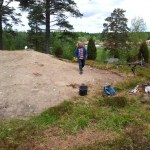archaeology
In March of 2011, the Swedish government launched a state commission under County Governor Eva Eriksson to evaluate our legislation and national goals regarding the cultural environment. Yesterday the commission delivered its report, in which a number of interesting suggestions are made for changes to the body of law that governs Swedish archaeology.
The current law contains a definition of the protected archaeological site that has never been enforced to the letter. First it says that any remains that bear witness to how people lived in the past and are permanently abandoned enjoy protection…
Spent the day digging with my friends Mattias Pettersson and Roger Wikell like so many times before. I like to join them on their sites for a day every now and then (2007, 2008, 2010). The two are mainly known as Mesolithic scholars, but I have been with them on a Neolithic and a Bronze Age site as well on previous occasions. And this time they're straight up my own alley of research: they're digging the largest of the Viking Period burial mounds in Tyresta hamlet's southern cemetery. Measuring eleven meters in diameter and about one-and-a-half in height, it's a pretty imposing structure…
Here's a novel way to present a cemetery excavation to visitors.
At Broby in Täby, one of the world's most runestone-rich spots, is the 11th century inhumation cemetery of the famous Iarlabanki family. My colleague Lars Andersson of Stockholm County Museum's archaeology service has been excavating it bit by bit for years. Many graves are exquisitely preserved. After finishing each piece of the site he covers it again with the original ploughsoil, leaving no visible trace of his interventions. How do you present such a site to the many visitors? (Täby is an affluent suburb of Stockholm.)
Lars…
Yet another case of that silly and damaging humanities idealism.
Last month the Daily Beast listed archaeology among the thirteen most useless major subjects at US colleges, as measured by employment opportunities and earnings potential. Bradley T. Lepper, curator of archaeology at the Ohio Historical Society, objects. He argues that archaeological knowledge is valuable to the long-term sustainability of a civilisation, and so the subject should be more highly valued. Whether true or not, this is beside the point. Daily Beast didn't list subjects that they think should by rights be poorly…
Current Archaeology #266 (May) has a big feature on the Medieval and Renaissance version of Saint Paul's cathedral in London. The current one designed by Christopher Wren, I learned, re-uses none of the earlier edifice's fabric and is not even orientated on the same axis. It was the world's first purpose-built Protestant cathedral, completed in 1710. What happened to the old cathedral? Well, first the Reformation, then a century of neglect while only the chancel remained consecrated, and then in 1666 the Great Fire of London. Finally Wren's building crew tore down whatever was left.
Then a…
I'm a month from my 20th anniversary as a professional archaeologist and I'm considering my options. Unlike most people who make a living in my trade I have not worked much in contract archaeology and I have spent only a few months on the dole. Instead my main source of income during these two decades has been research grants from private foundations. Not big ones, but many of them. With a frugal lifestyle and no departmental overhead, I have produced more publications per krona than most. This has increased my chances of finding renewed funding. Publish or Perish has been my rule. Secondary…
My buddy Claes Pettersson is a field archaeologist in Jönköping and always has a lot of fun projects going. Last year he told me about an undocumented manor park he had studied through geophysics. Right now he's digging bits of Jönköping's obliterated castle. And recently he sent me an intriguing little fieldwork report (available on-line for free). It's a piece of, not exactly battlefield archaeology, but campaign archaeology, which is rare.
The back story is short and nasty. Sweden fought the Northern Seven Years' War from 1563 to 1570 against Denmark-Norway, Lübeck and the Polish-…
Spring is late this year in Sweden, and the weather has been dreary. But now things have perked up, and suddenly I felt the itch to get out and check out some sites before the leaves and grass sprout in earnest and ruin visibility. So Sunday night I hurriedly checked through my database of Bronze Age sacrificial finds and picked out two nearby sites where the find spots are known to good precision. I printed out maps from the sites & monuments register and checked for coeval rock art & burnt mounds nearby. And I got the 1000 BC shoreline map for each site from the Swedish Geological…
Livescience.com asked me a bunch of question about the Ales stenar stone ship on the occasion of Mörner & Lind's new bizarro paper. They didn't use much of what I wrote, so I'll put it up here.
LS: What is the most remarkable thing -- physical, historical or otherwise - about Ales Stenar?
MR: Its excellent state of preservation and restoration. These large stone ships form a common category of monuments, but few are currently as nice-looking as this one. (Ales stenar is not one of the largest ones we're aware of.) Also it sits in a scenic spot in one of Sweden's main tourist regions.
LS…
Fornvännen is not only a paper quarterly on its 107th year, but also an Open Access journal that appears for free with a 6-month delay. The autumn issue for 2011has just gone live! All papers have English abstracts and summaries.
Påvel Nicklasson on 19th century zoologist and pioneering archaeological theorist Sven Nilsson.
Roger Wikell et al. on the horse that pulls the sun on a recently identified Bronze Age rock carving in Östergötland.
Svante Fischer et al. on a major new solidus coin hoard from Åland, in English.
Ulrika Stenbäck Lönnquist and Stig Welinder on the whys and wherefores of…
Perennial Aard favourites N-A. Mörner and B.G. Lind have published another note in a thematically unrelated journal. It's much like the one they snuck past peer review into Geografiska Annaler in 2009 and which Alun Salt and I challenged in 2011. The new paper is as usual completely out of touch with real archaeology, misdating Ales stenar by over 1000 years and comparing it to Stonehenge using the megalithic yard. No mention is made of the fact that this unit of measurement was dreamed up by professor of engineering cum crank archaeoastronomer Alexander Thom and has never had any standing in…
"The river channel at Must Farm, with bronze age fish traps and weirs, logboats and many bronze objects. The roddon is raised land formed from old river silts."
I wrote in January about the Must Farm / Flag Fen Bronze Age dugout boats at Peterborough, England when Current Archaeology covered them. Now British Archaeology has done likewise (the two mags' staff must bump into each other at British excavations all the time judging from their coverage), and there's a beautiful plan drawing in issue #123 (March/April). It fascinates me, as it has such relevance to my current research.
The dig at…
In discussing the relevance of archeology to anything, there is an easy answer provided by my friend Peter Wells, a specialist in Culture Contact and the Central European Iron Age. Peter tells his students on the first day of class that "Archaeology is the study of everything that happened anywhere, any time, with any human beings that ever existed or exist now." And if you think that he is exaggerating, you don't know much about Archaeology.
Recently, my friend Elizabeth Reetz has asked a more narrowly defined question: "What are the benefits of environmental education through…
Science publishing is at a crossroads. On We Beasties, Kevin Bonham says that early scientists "communicated amongst themselves in person or in letters or in books. They shared discoveries freely and it was possible for an individual human to be aware of almost the entire sum of human knowledge." As the pace of discovery accelerated, scientific journals became instrumental in recording and disseminating knowledge. But today, while earnest researchers must "publish or perish," and millions of students stand to benefit from open access, publishers themselves are focused on turning a profit…
Yesterday I went to Jutish Viborg by train, plane and bus. This took a bit less than eight hours. Exiting Aalborg airport into the icy sleet I managed to walk straight into the glass wind breaker outside the turnstile, banging my forehead and knee. Everybody around studiously avoided noticing my antics. On arriving in Viborg I found the museum, met some colleagues and received a key for the visiting scholars' building at Asmild that I'm staying in. Then to the city library where there is warmth and (flaky) wifi, and where I am now sitting again. Wednesday ended in good company with…
Almost exactly one year ago, a very large double strength tsunami struck the Pacific Coast of Japan and washed a huge amount of stuff out into the sea. The oceanic born debris of terrestrial origin looked in places like this:
source
Subsequently attempts were made to model the movement of the debris in the Pacific. Some of the debris would likely end up on the coast of the US, so some of the models asked that question: When can Tsunami Salad start to wash up on the beaches of California, Oregon and Washington? I'm sure that everyone who's thought about this for even a few seconds realizes…
Shortly after Fornvännen 2012:1 reached subscribers on paper, issue 2011:2 has now been published on-line. Get thee there, Dear Reader, and read for free (not dearly)!
Joakim Wehlin on why some of Gotland's mightiest Bronze Age monuments were built next to the island's single megalithic tomb of the Early Neolithic.
Karl-Magnus Melin on ancient wells.
Torun Zachrisson makes an interesting suggestion as to where the church of Birka may have been located.
Jürgen Beyer tries to make sense of some semi-literate 16th century epigraphy in Plattdeutsch on Gotland.
Tryggve Siltberg criticises…
The Royal Swedish Academy of Letters, History and Antiquities is over 250 years old and consists almost entirely of professors of the humanities and social sciences. But don't let that fool you into thinking that it's a sleepy organisation. For one thing, the Academy is a signatory of the 2003 Berlin Declaration on Open Access to Knowledge in the Sciences and Humanities. And so the venerable paper journal I edit, Fornvännen, is one of the first and most successful Open Access journals in the Swedish humanities. Increasingly, the Academy is also putting out the paper books it publishes as Open…
There are some good archaeology-themed boardgames out there. None depict archaeology as an activity directed towards the gaining of knowledge. Let's look at the top three on Boardgame Geek.
Tikal has a pretty absurd premise. A number of archaeological expeditions reach an area of jungle-covered ruins in the Yucatan peninsula at the same time and realise to their surprise that they all have permits to dig in the same region. The expedition leaders react to this coincidence by ordering an all-out plunderfest where everybody tries to get as much fine loot as possible, employing the locals as…


